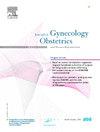Profile of pregnant women complying or not with physical activity recommendations during the second trimester of pregnancy: A French pilot study
IF 1.6
4区 医学
Q3 OBSTETRICS & GYNECOLOGY
Journal of gynecology obstetrics and human reproduction
Pub Date : 2025-08-09
DOI:10.1016/j.jogoh.2025.103007
引用次数: 0
Abstract
Introduction
Insufficient physical activity (PA) during pregnancy is a global public health concern. The aims of this study were: i) to determine retrospectively PA and sedentary time in women in the second trimester of pregnancy, and ii) to identify factors that influence adherence to the French National College of Midwives guidelines on PA (≥150 minutes of moderate to high-intensity PA per week).
Methods
This cross-sectional, single-centre study, conducted at the University Hospital of Rennes, included 195 pregnant women. PA levels and sedentary time before and during the second trimester of pregnancy were determined using an anonymous self-report questionnaire. The self-reported PA levels were compared to the guidelines on PA. Bivariate analyses and Poisson generalized linear regression models were used to identify factors associated with non-compliance to such guidelines.
Results
Only 30.7 % of pregnant women reported the recommended PA levels in the second trimester of pregnancy. Sedentary time and adherence to the PA guidelines were not associated. Fatigue was the most frequently cited reason for insufficient PA (71.6 %). Preconception PA level was the strongest predictor of adherence. Body mass index >25 kg/m², <2 years of higher education, limited access to transportation and sports facilities, and living in a town with <2.000 inhabitants also were associated with lower PA levels.
Conclusion
Adherence to the PA recommendations is low among French pregnant women. Public health initiatives should emphasize PA importance before pregnancy and provide tailored support throughout gestation. Future studies should explore the interplay between PA, sedentary time and pregnancy outcomes.
孕妇在妊娠中期遵守或不遵守体育锻炼建议的概况:一项法国试点研究。
孕期身体活动不足(PA)是一个全球性的公共卫生问题。本研究的目的是:1)回顾性地确定妊娠中期妇女的PA和久坐时间,2)确定影响法国国家助产士学院PA指南(每周≥150分钟的中高强度PA)依从性的因素。方法:这项横断面、单中心研究在雷恩大学医院进行,包括195名孕妇。研究人员使用匿名自我报告问卷来确定怀孕前和怀孕中期的PA水平和久坐时间。将自我报告的PA水平与PA指南进行比较。使用双变量分析和泊松广义线性回归模型来确定与不遵守此类指南相关的因素。结果:只有30.7%的孕妇在妊娠中期报告了推荐的PA水平。久坐时间与遵守PA指南无关。疲劳是最常见的PA不足的原因(71.6%)。孕前PA水平是依从性最强的预测因子。结论:法国孕妇对PA建议的依从性较低。公共卫生倡议应强调孕前PA的重要性,并在整个妊娠期间提供量身定制的支持。未来的研究应该探索PA、久坐时间和妊娠结局之间的相互作用。
本文章由计算机程序翻译,如有差异,请以英文原文为准。
求助全文
约1分钟内获得全文
求助全文
来源期刊

Journal of gynecology obstetrics and human reproduction
Medicine-Obstetrics and Gynecology
CiteScore
3.70
自引率
5.30%
发文量
210
审稿时长
31 days
期刊介绍:
Formerly known as Journal de Gynécologie Obstétrique et Biologie de la Reproduction, Journal of Gynecology Obstetrics and Human Reproduction is the official Academic publication of the French College of Obstetricians and Gynecologists (Collège National des Gynécologues et Obstétriciens Français / CNGOF).
J Gynecol Obstet Hum Reprod publishes monthly, in English, research papers and techniques in the fields of Gynecology, Obstetrics, Neonatology and Human Reproduction: (guest) editorials, original articles, reviews, updates, technical notes, case reports, letters to the editor and guidelines.
Original works include clinical or laboratory investigations and clinical or equipment reports. Reviews include narrative reviews, systematic reviews and meta-analyses.
 求助内容:
求助内容: 应助结果提醒方式:
应助结果提醒方式:


